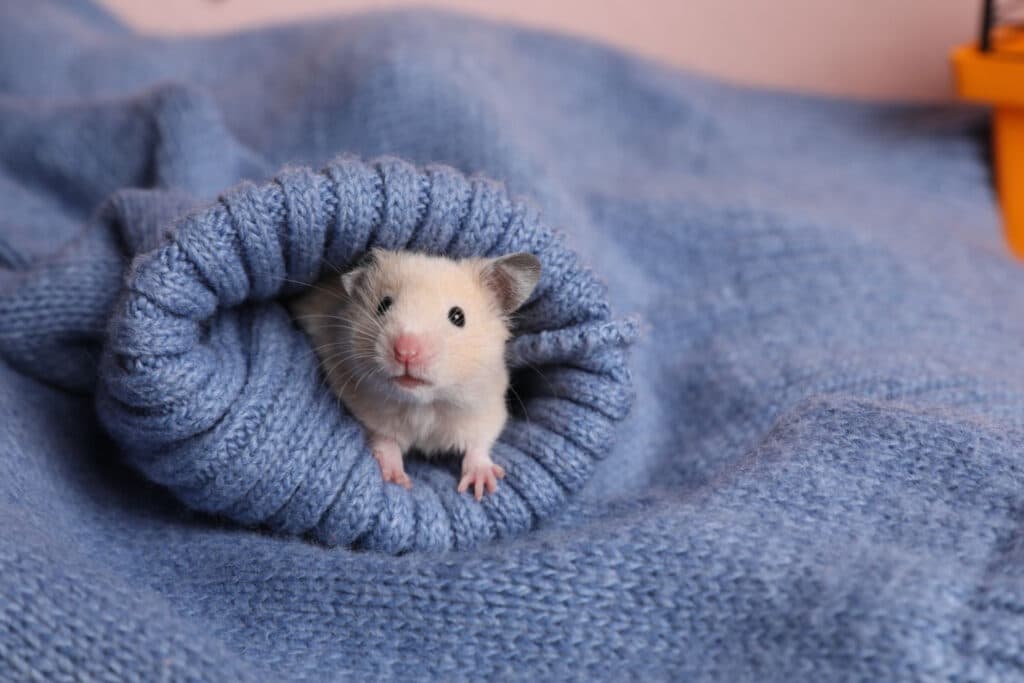Hamsters are tiny creatures that cannot survive in harsh conditions. For your hamster to stay healthy, the room temperature should always be between 18°C to 24°C. If the temperature drops below 18°C, his health can be impacted severely. But how to keep your hamster warm without spending a ton of money on heating? Keep reading to find out.
Keeping your hamster warm in winter
Winter is a time that not many people like. The cold temperatures and the increased accidents due to skiddy roads make it one of the most hated seasons. While accidents are not within the scope of this blog post, the cold temperatures are. So, we will delve a little deep into that.
Even though both humans and hamsters (as are all mammals and birds) are warm-blooded animals who can regulate our internal body temperatures to survive in harsh weather, there is a limit to how much our bodies can handle. Even we cannot survive if the environment is too hot or too cold.
What happens to your hamster if it is too cold?
Cold temperatures can make our immune systems less effective (Source: Proceedings of the National Academy of Sciences, USA) while helping cold-causing rhinovirus reproduce faster in our bodies (Source: The Discover Magazine). Thus, cold temperatures make both humans and hamsters more prone to catching a cold.
When it gets too cold, hamsters can start hibernating. In the wild, hamsters know when seasons change. So, when it starts getting cold, they eat a lot before hibernating. So their bodies will have enough energy to survive hibernation. But pet hamsters do not have enough time to prepare for hibernation if the temperature drops suddenly. So, hibernation can be deadly for pet hamsters.
Cold temperatures can be deadly not only for your hamster but also for you. Prolonged exposure to cold temperatures can affect our bodies adversely, causing hypothermia (abnormally low body temperature, which makes it difficult to think clearly or move), frostbites, etc. Repeated exposure to not-that-cold temperatures (< 16°C) can also impact our health, causing chilblains (damage to the blood vessels in the skin causing redness and itching) and Trench foot (injury to the feet due to prolonged exposure to wet and cold conditions). So, cold temperatures can be deadly even for humans (Source: Centers for Disease Control and Prevention).
Therefore, you should keep your house warm in winter so that you and your hamster can stay healthy.
How to keep your room warm in winter?
The easiest way to keep your house warm in winter is to switch on the room heater. But if your hamster is too close to the heater, it might become too hot for him. So, do not place the cage too close to the heater.
The room heater should be able to heat the room sufficiently so that the room temperature lies between 18°C and 24°C.

Problem with keeping the room heater switched on for a long time
If you keep the heater switched on constantly (which might be the case if you own a hamster), it can make the air in the room warmer. Once air gets warmed beyond a certain point, it starts absorbing moisture. It can even draw moisture from your body, making your skin dry.
Air is normally drier in winter months (average humidity of 8%). On top of that, if you keep your room heater switched on, the air in your room can become super dry, making it difficult for your hamster to breathe. Hamsters need humidity levels of 40% to 60% to stay healthy (Source: Wikipedia). If the humidity is too low, they can start coughing, scratching (because the skin becomes dry and itchy), and losing hair.
Opening the window might not help in increasing the humidity either because the air outside will also be dry. A better choice would be to use a humidifier to increase the moisture in the air (Source: Hoff Heating & AC Inc.). Moist air can help your hamster breathe easily and also help hydrate his skin, making it smooth. Moist air can also help remove bad smells from your hamster and keep his fur healthy.
Often, the room temperature may not be the same as the temperature in the hamster cage. So, keep a thermometer in the cage to measure the temperature in the cage (Source: Youtube). Turn the room heater up or down so that the temperature in the cage lies between 18°C and 24°C. Do not forget to ventilate the room at regular intervals so that fresh air comes in.
How to keep your hamster warm on a low budget?
Until now, we talked about how to use the room heater optimally. But what do you do if you do not want the room heater to run the entire day?
At the time of writing this article, it is the January of 2023. Russia has attacked Ukraine. And Germany has imposed sanctions on Russia. In retaliation, Russia has stopped the gas supply to us (I am an Indian living in Germany). Long story short, gas is pretty costly here. So, we have to use as less gas as possible for heating, which is the recommendation of the government as well.
So, what do you do if you find yourself in a similar situation? Or what if you have placed your hamster cage in a big room that doesn’t heat up so quickly? How do you keep your hamster warm even if your house is cold? What do you do to help your hamster get through cold winters without spending a ton of money?
There are three steps you can take to help your hamster get through cold winters without spending too much money – 1. Keep the entire room warm, 2. Keep the cage warm, 3. Keep your hamster warm. Ideally, these three things should work in tandem with each other, i.e., you should focus on doing all these things, not just one of them. So, without further ado, let’s cut to the chase and find out how you can do that.
I. Cheap ways to keep your room warm in winter
You don’t have to keep the heater on the whole day for the room to be warm. You can follow some simple measures to insulate the room so that the generated heat stays in the room longer (Source: BBC). By following the steps below, you can keep your heating costs down while keeping the room warm enough for your hamster.
1. Use Curtains
Curtains are a great way to keep the generated heat within the house. They can reduce heat loss by about 40%. Make sure that the curtain is as close to the window as possible without touching it so that warm air has less chance of escaping. Velvet, heavy silk, and suede with close weaves are better at insulating than cotton, linen, and lace (Source: Harrisons Curtains and Binds). Moreover, curtains can make your house look more appealing.
2. Use sunlight efficiently
Keep the curtains and blinds open during the day to utilize the free and natural source of heat, the sunlight. Close the curtains before nightfall so that the heat generated during the day does not escape outside during the night.
3. Use carpets
Floors account for about 10% of a room’s heat loss. Carpets can reduce that amount drastically.
4. Keep your radiators clear
If you have a large piece of furniture, like a sofa, in front of the room heater, it will absorb most of the heat from the radiator. So, you won’t be heating your room that efficiently. So, keep your furniture away from the heater.
5. Use shelves
If your heater is below a window with curtains, put a shelf above the heater so that the hot air rising from the heater does not get trapped between the window and the curtain.
6. Cover draughts
Any and all sort of insulation becomes useless if there is a draught (a current of cool air) in the room. So, make sure all draughts in the room are properly insulated. For example, keyholes can be covered using circular keyhole covers, cat or dog flaps can be filled with pieces of blanket or other insulating material, and the small space under doors can be covered using towels.
7. Close the room
If you have switched on the heater in only one room, keep it closed as much as possible. It will keep your heating more efficient by preventing cold air from the rest of the house from coming in.
II. Cheap ways to keep the hamster cage warm in winter
Until now, we looked at how you can keep your hamster’s room warm. Now let’s look at how you can keep your hamster’s cage warm.
1. Pick the right cage
If you think it will be difficult for you to keep the room warm at all times, the first thing you can do as a hamster owner is to pick the right hamster cage. Metal and wire cages are open. So they do not stop the cold air in the room from getting into the cage. But glass tanks are closed (They have a hole for ventilation, though). Moreover, glass is a bad conductor of heat. So, it acts as an insulator, preventing the heat inside the cage from escaping outside.
Therefore, buying a glass tank can help keep heating costs under check.
2. Choose a warm place for the cage
Where you place your hamster cage also has an effect on how warm it is. Do not place it near a window. Even if the window is closed, the air near the window is bound to be colder than the rest of the room. If there are any uncovered draughts, like below the doors, do not place the cage near them.
3. Use blankets for insulation
In an earlier section of this blog post, I explained how floors account for 10% of a room’s heat loss and how you can prevent it by using carpets. In a similar manner, the cage floor can also contribute to heat loss. To prevent it, you can keep a blanket under the bedding and above the cage floor.
You can also cover your hamster cage at night using a blanket if you are concerned that it can get too cold for your hamster. But do you remember how we talked about hot air can absorb humidity? So, if the entire cage is covered with a blanket, the cage can become too hot and dry, making it difficult for your hamster to breathe. So, cover the hamster cage only as a last measure, and even if you do, keep a portion of the cage uncovered for ventilation.
4. Use Space heaters
Depending on which fuel your room heater uses, up to 70% of the energy can be lost while converting the fuel to energy (Source: Yahoo Finance). So, if the room is too big and the room heater takes too long to heat the room, a space heater can be a cheaper alternative.
A space heater is a portable heater used to heat a smaller area (Source: Wikipedia). It can be cost-effective if you need to heat only a small portion of the room in which your hamster is.
You can also connect the space heater to a timer so that the timer switches off after a specific time (This website explains how to do it: Heatertips).
Even better, you can connect the space heater to a digitally programmable thermostat to maintain a constant room temperature at all times (This website explains how to do it: Instructables). This way, you can keep your hamster safe and comfortable by maintaining a constant temperature while keeping the heating costs low.
III. Cheap ways to keep your hamster warm even if the house is cold
The final step is to keep your hamster warm. Even if your house is cold, you can use the below methods to keep your hamster warm.

1. Provide enough bedding
You should provide your hamster with sufficient bedding (At least 12″ deep for Syrian hamsters and 6″ deep for dwarf hamsters) to simulate their natural burrowing behavior. But bedding is also important for your hamster to protect himself when it gets too cold.
In the wild, hamsters gather leaves and twigs in their burrows to protect them from the cold weather outside. Your pet hamster will do the same – He will gather as much bedding as possible to his hideout if it gets too cold for him. So, provide extra bedding for your hamster if he needs it.
You can also provide him with other materials like tissues, newspapers, and soft clothing. These are all bad conductors of heat. So they will help him preserve his body heat.
2. Provide places for your hamster to hide
In the wild, hamsters live in burrows. Since the burrows are deep under the ground, the earth above the burrows does not collapse. So, wild hamsters can bring leaves and twigs into this closed space to make it warm.
But the hamster bedding is not the same as soil. If your hamster burrows inside it, these burrows may collapse anytime. So, buy a hamster hideout available online and keep it in your hamster’s cage. Your hamster can pull the bedding into this hideout to create a cozy, warm nest, just like a wild hamster pulling twigs and leaves into his burrow. It can help keep him warm even if the surrounding is cold.
If you find commercial hideouts to be costly, you can make one yourself using the materials available in your house.
3. Play with your hamster
Hamsters are tiny creatures that can become obese and diabetic easily. They need a lot of exercises to prevent these conditions.
But if it is too cold, your hamster might start becoming lethargic and stop exercising to conserve energy. So, you have to engage with your hamster every day. Take him outside of his cage and keep him on the floor or sofa and play with him. Increased activity can also keep him warm while keeping diabetes and obesity at bay and helping you build a bond with him.

Playing music like metal or rock can also make your hamster more active. But metal and rock genres may not have the same effect on all hamsters. If your hamster becomes more active by listening to music, there is nothing you have to worry about. However, if your hamster becomes agitated and aggressive after listening to it, you should immediately stop playing it. Also read: Do hamsters like music?
4. Take care of your hamster’s diet
If you are playing with your hamster regularly, he can expend a lot of energy. So, keep adequate food and fresh water for him every day.
The fat in the body not only acts as an insulating shield protecting the core body from cold temperatures but also burns calories and releases heat to warm the body (Source: Science). Therefore, add food items that contain healthy fats (seeds, nuts, etc., not burgers and pizza) to your hamster’s diet during winter.
5. Use in-cage heating equipment
In the previous sections of this blog post, we saw how you could keep the room and the hamster cage warm using room heaters and space heaters. But there is another way to keep your hamster warm in winter – By using in-cage heating equipment.
Just like a bonfire keeps you warm on a cold winter night, this equipment can keep your hamster warm.
The easiest and cheapest ones are warm water bottles. You can buy one and keep it inside the cage out of reach of your hamster. If your hamster gets cold, he can come near the water bottle to warm himself up. If the hot water bottle is somewhere where your hamster can reach it, cover it with a thick towel so that your hamster doesn’t burn himself by touching it.
You can also use a heating bag or pad. Buy a reptile under-tank heating pad and keep it under the bedding on one side of the cage. When your hamster gets too cold, he can move to the side of the cage where the heating pad is placed. If he feels it is too warm, he can move to the other side of the cage (Source: Hamsters 101).
However, if you have a glass water tank, you may not need this in-cage heating equipment because the glass tank is a good insulator. So, it prevents the heat inside the cage from escaping outside. So, it could be sufficient if you just add more bedding to the cage.
Worst-Case Scenario
If you follow the steps above, your hamster should not feel cold at all. But what do you do if your hamster feels cold despite all your best efforts?
Firstly, as a hamster owner, you should constantly be observing your hamster’s behavior to make sure that he is healthy. You should be even more vigilant in the winter.
If you find any symptoms of a common cold (Wet/runny nose, sneezing/coughing, loss of appetite, lethargy, matted fur, etc.) in your hamster, you should take him to a vet. The vet will prescribe medicines that will not cure the cold but will ease your hamster’s pain by relieving the symptoms. The cold will remain mostly for five days.
If your hamster has caught a cold, it will go away. But what if you find your hamster going into hibernation? What do you do in this worst-case scenario?
What to do if your hamster is going into hibernation?
Once your hamster starts hibernating, he will become unresponsive. He will almost look like he is dead and feel cold if you touch him. You will find his breathing and heart rate to be very low. Hibernating can be deadly for pet hamsters. Even though they might stock up on food, they might not have prepared (eating a lot of food) properly. Moreover, they can also get dehydrated.
So, the first thing you have to do is to bring your hamster out of hibernation mode. Get him into a warm environment quickly. If your hands are warm enough, you can keep your hamster in your hand and cover him with your hands (Don’t forget to give him some space to breathe). If that doesn’t wake him up, take a towel, warm it up by placing it on a heater and cover your hamster using the warm blanket. But make sure that the towel is not too hot.
Once your hamster comes out of hibernation, give him some warm milk or water with electrolytes to hydrate him (For more information, read: Do hamsters hibernate?).
Consult a vet if your hamster takes too long to come out of hibernation or becomes sick after coming out of hibernation.



